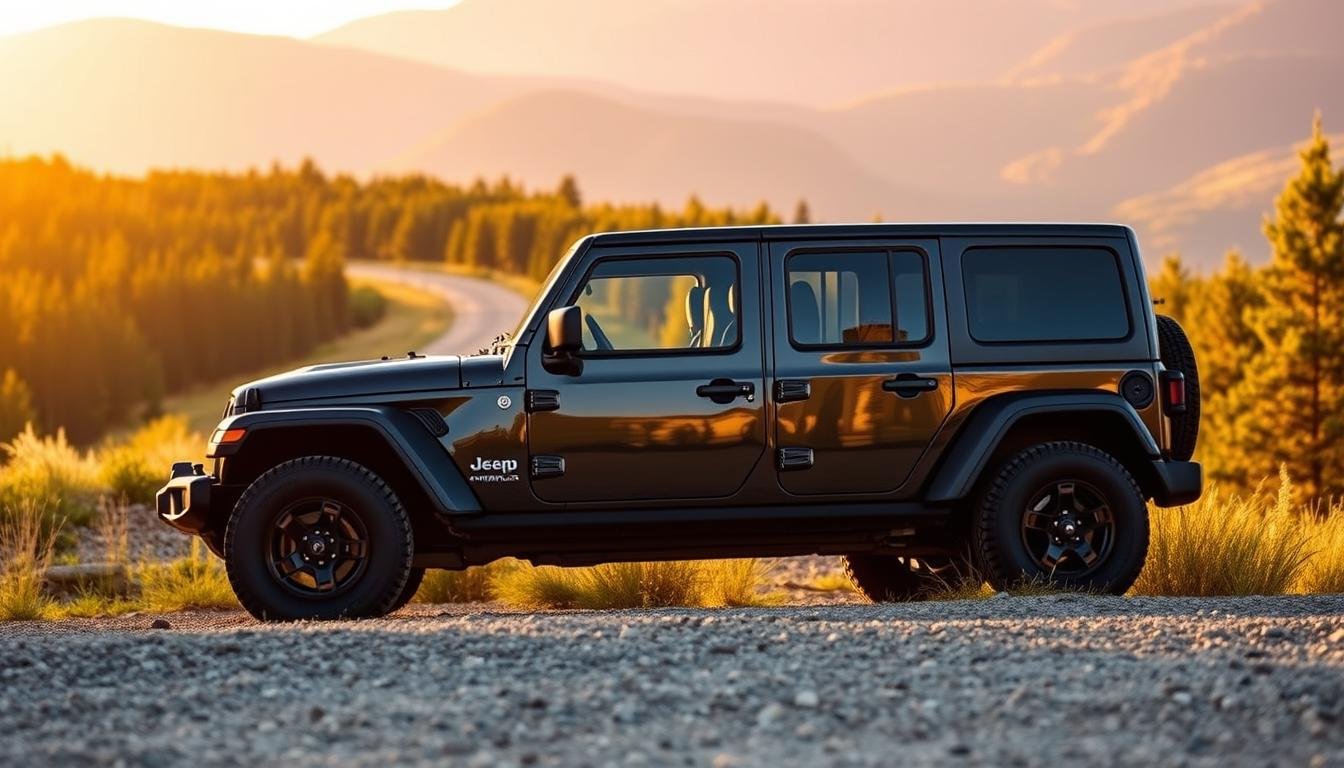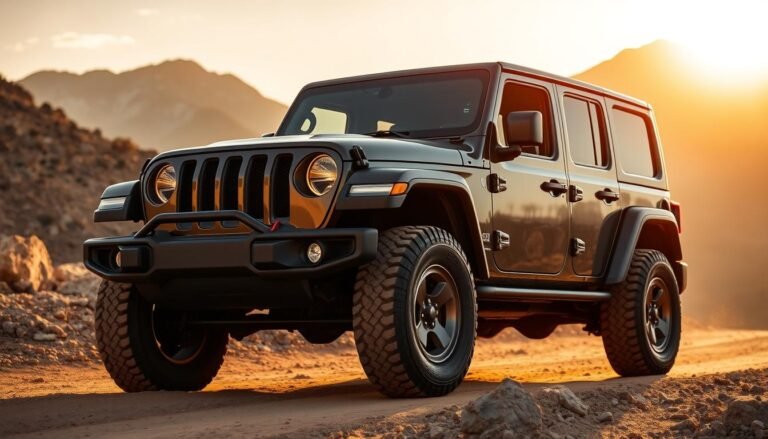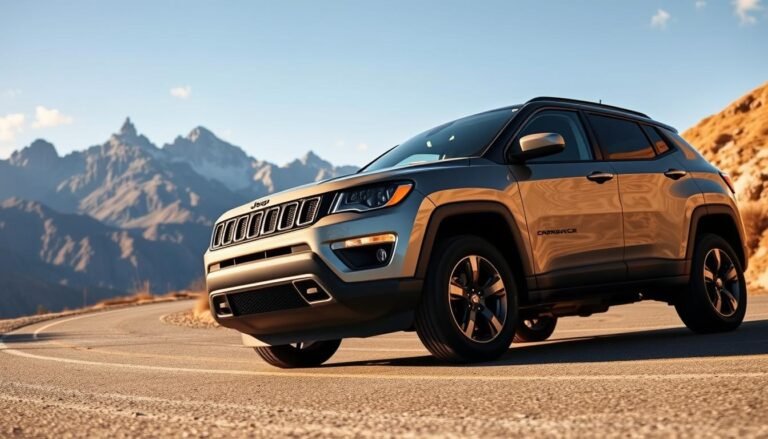Jeep Wrangler Fuel Economy: Exclusive 9 Efficiency Insights
How efficient is the Jeep Wrangler? Different engines and features mean fuel economy varies. Known for its off-road prowess, many wonder about its fuel efficiency.
Learning what impacts fuel economy is crucial. This article explains how various engines, including hybrids, affect fuel efficiency.
You’ll also get tips to boost it. We’ll look at how transmission and vehicle setup can change your driving experience.
You’ll also learn about average MPG ratings for different Wrangler models, from gas to hybrids. With this info, you can improve your Jeep’s fuel economy and still enjoy its power.
Introduction To Jeep Wrangler Fuel Economy
The Jeep Wrangler is known for being rugged and great off-road. Many fans love these features but don’t think much about jeep wrangler fuel economy.
In the past, Jeeps weren’t the best on gas. But now, new technology and designs have started to change that.
Whether you’re hitting the trails or just driving to work, knowing about jeep wrangler gas mileage matters.
With better engines and even hybrid options, Jeeps are now more gas-friendly. They still keep their powerful, fun drive. This makes them perfect for both adventure and everyday needs.
When looking at different models and fuel options, remember that using less fuel saves money and suits many driving needs.
Knowing about fuel economy helps you pick the best Jeep Wrangler for your life. It’s smart and makes picking the right one easier.
What Affects Jeep Wrangler Gas Mileage?
Different engines in the Jeep Wrangler impact its gas mileage. Each engine has its own level of efficiency. The type of transmission you choose is key too.
For example, automatic and manual transmissions don’t perform the same in terms of gas use. The Jeep’s weight also plays a role in its fuel consumption.
Lighter cars use less gas, so it’s worth considering how to make your Jeep lighter. The number of doors and any added accessories also change how your Jeep performs.
Where and how you drive affects gas mileage too. City driving usually means lower gas mileage because of the stop-and-go traffic.
On the highway, your Jeep can run more efficiently with steadier speeds. How you drive—like speeding up or braking hard—can also make a difference.
By understanding what impacts Jeep Wrangler’s gas mileage, you can make better choices. You can help improve your Jeep’s fuel economy for your trips this way.
Jeep Wrangler MPG by Engine Options
The Jeep Wrangler comes with different engine options, each with its own fuel efficiency.
Knowing these details can help you pick the right one for your needs. Let’s look at these engines and their MPG ratings.
3.6-Liter Pentastar V-6
This engine offers a good mix of power and fuel economy. With the 2-door model, you get about 17 MPG in the city and 23 MPG on the highway.
It’s a solid choice among gasoline engines, offering 19 MPG combined.
2.0-Liter Turbo Four-Cylinder
The 2.0-Liter Turbo is great for saving on gas. It gets around 20 MPG in the city and 23 MPG on the highway.
For those wanting less gas use but still good performance, this is your engine, giving 21 MPG combined.
2.0L Turbocharged Plug-In Hybrid (4xe)
If getting the best MPG in a Jeep Wrangler is your goal, consider the 2.0L Turbo Plug-In Hybrid (4xe).
It’s very efficient, with an EPA estimate of 49 MPGe. This model mixes electric with gasoline power for superb efficiency.
6.4-Liter HEMI V-8
The 6.4-Liter HEMI V-8 is all about power. But, this power comes at the cost of fuel efficiency, with just 13 MPG in the city and 16 MPG on the highway.
If you prefer power above fuel savings, this engine is for you, yielding 14 MPG combined.
| Engine Option | City MPG | Highway MPG | Combined MPG |
|---|---|---|---|
| 3.6-Liter Pentastar V-6 | 17 | 23 | 19 |
| 2.0-Liter Turbo Four-Cylinder | 20 | 23 | 21 |
| 2.0L Turbocharged Plug-In Hybrid (4xe) | Not Applicable | Not Applicable | 49 MPGe |
| 6.4-Liter HEMI V-8 | 13 | 16 | 14 |
Jeep Wrangler Fuel Economy: Transmission Impacts
The type of transmission you choose greatly affects your Jeep Wrangler’s fuel efficiency.
With the six-speed manual transmission and 3.6-liter V-6 engine, you’ll see about 17 MPG in the city and 23 MPG on the highway.
This setup gives you a hands-on feel but might not be the best for saving gas. However, the eight-speed automatic transmission offers better fuel efficiency.
This combo gets you 18 MPG in the city and 24 MPG on the highway. For those wanting to get the most out of their fuel, the automatic is a great choice.
Choosing the right transmission impacts how your car drives and its efficiency. Keeping these factors in mind helps you pick what’s best for your fuel goals.
| Transmission Type | City MPG | Highway MPG | Combined MPG |
|---|---|---|---|
| Six-Speed Manual | 17 | 23 | 19 |
| Eight-Speed Automatic | 18 | 24 | 20 |
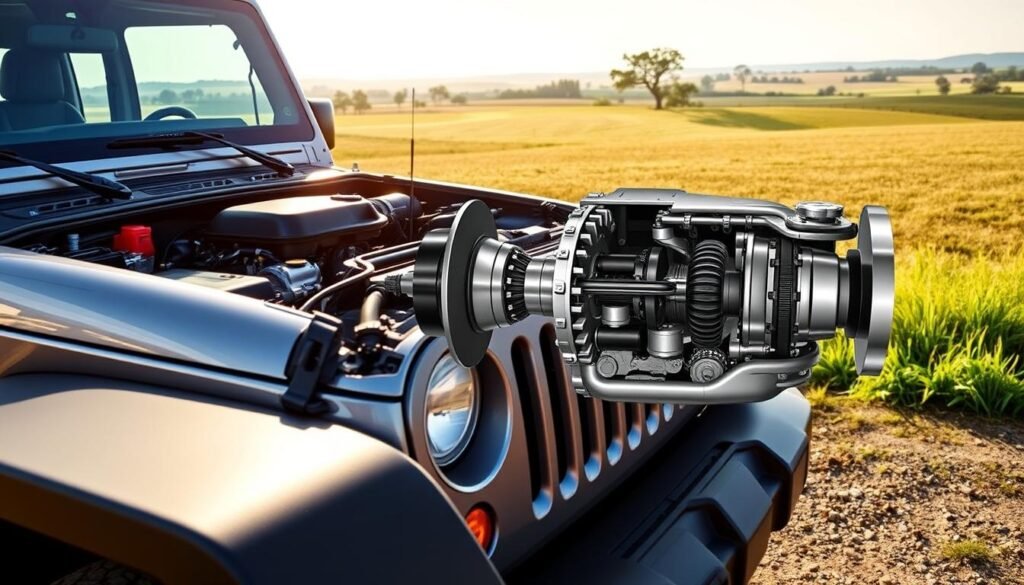
Jeep Wrangler MPG by Door Count
The number of doors on your Jeep Wrangler impacts its gas mileage. Two-door models often get better MPG than four-door ones because they weigh less.
For instance, a two-door with a 3.6-liter V-6 engine gets about 17 MPG in the city and 23 MPG on the highway. This sums up to an average of 19 MPG.
On the other hand, the four-door version has slightly lower MPG. It gets 16 MPG in the city and 22 MPG on the highway but still averages 19 MPG overall.
This section talks about how door count affects MPG. We’ll give you details to help you decide what’s best for your driving needs. Plus, we’ll share tips on saving gas with your Jeep Wrangler.
| Model | City MPG | Highway MPG | Combined MPG |
|---|---|---|---|
| Two-Door 3.6L V-6 | 17 | 23 | 19 |
| Four-Door 3.6L V-6 | 16 | 22 | 19 |
Jeep Wrangler MPG by Trim Levels
Looking into the Jeep Wrangler MPG by trim levels helps us see how different setups impact fuel use.
The Wrangler offers many trims with unique features that affect gas mileage. The Sport, Sport S, and Willys models have a 3.6-liter V-6 engine.
They usually get around 17 MPG in the city and 23 MPG on the highway. Their average MPG is 19. These trims combine strong performance with decent efficiency.
On the other hand, the Sahara trim has a turbo engine and comes in a four-door version.
It provides better MPG rates: 20 in the city, 22 on the highway, and an average of 21 MPG. Knowing the MPG differences helps pick the right model for your needs and style.
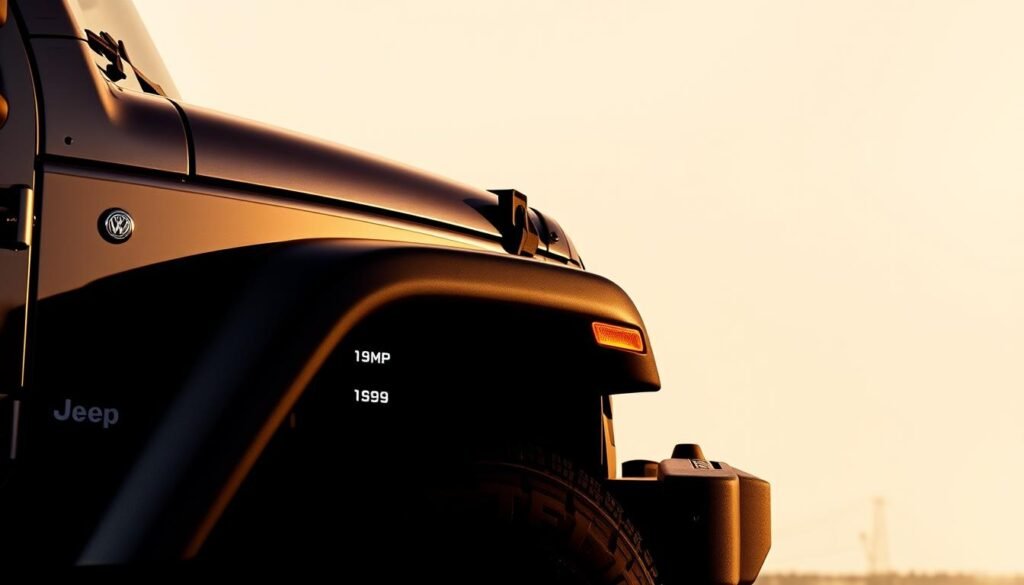
Average Fuel Economy Estimates
Getting to know the fuel economy of the 2024 Jeep Wrangler lineup helps in choosing the right vehicle.
The numbers change based on the engine and how the car is set up. This helps future owners decide what fuel usage works best for them.
Combined MPG Ratings
The Jeep Wrangler’s MPG ratings fall between 17-24. This is due to the different engines and configurations available.
Choosing engines like the 3.6-Liter Pentastar V-6 or the 2.0-Liter turbo helps balance fuel use and power.
City and Highway MPG Averages
In the city, you’ll find MPG numbers are lower, from 13 to 20. This means you’ll need to fill up the tank more often in town.
On highways, it’s a different story. You get between 20 and 26 MPG, making long trips less worrying about fuel.
Improving Jeep Wrangler Fuel Economy
Making your Jeep Wrangler use less fuel can be easy. Start by keeping up with regular maintenance.
Changing the oil and checking the air filter regularly helps your engine run better. This also stops sudden repairs that can waste fuel.
Checking your tire pressure is also key. Make sure your tires have the right amount of air, as suggested by the maker.
Tires without enough air make your Jeep use more fuel, which can hurt its performance and fuel use.
Try to carry less weight in your Jeep. Not hauling extra stuff can help you use less fuel.
Also, driving fast and stopping hard can make your fuel economy worse. By driving more smoothly, you can use fuel more efficiently.
Using these tips for better jeep wrangler fuel efficiency helps you save on gas and keeps your Jeep running longer. Every little thing you do adds up to big fuel savings.
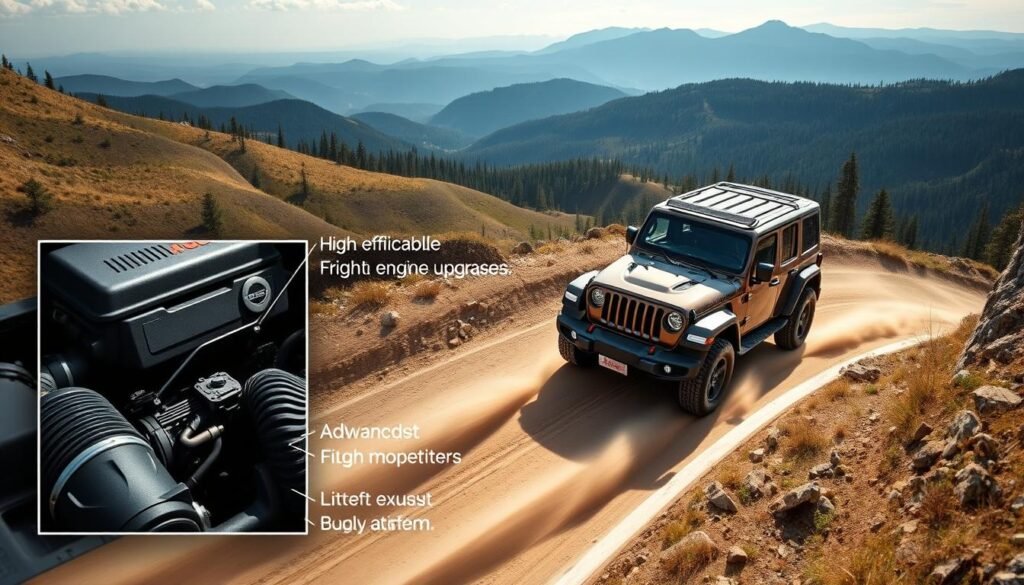
Eco-Friendly Jeep Wrangler Fuel Solutions
The Jeep Wrangler is keeping up with the times by putting out greener fuel solutions. The 2.0L Turbocharged Plug-In Hybrid (4xe) leads the way.
It surprises with an EPA-estimated 49 MPGe. This model mixes the Wrangler’s tough features with less fuel use and fewer carbon emissions.
Now, Wrangler owners have more eco-friendly choices with conversion kits. These kits let you switch to biodiesel or CNG (compressed natural gas).
This shift makes it simpler to cut down on environmental harm. All while you enjoy the Jeep’s promise of adventure.
Take a look at the following comparison of available eco-friendly fuel options for your Jeep Wrangler:
| Fuel Type | EPA Estimated MPGe | Carbon Footprint Reduction |
|---|---|---|
| 2.0L Turbocharged Plug-In Hybrid (4xe) | 49 MPGe | Up to 50% |
| Biodiesel Conversion Kit | Varies | Up to 30% |
| CNG Conversion Kit | Varies | Up to 40% |
Choosing these eco-friendly solutions for your Jeep Wrangler helps our planet. You can still enjoy its strong performance and flexibility.
Look into these options to find what’s best for the way you drive.
Maximizing Fuel Economy in A Jeep Wrangler
To get the best mileage from your Jeep Wrangler, regular upkeep is key. It helps your vehicle run well, which is vital for saving fuel.
Here are some top maintenance and driving tips to boost your vehicle’s efficiency.
Regular Maintenance Tips
Sticking to a maintenance timetable keeps your Jeep in great shape. Important practices include:
- Frequent oil changes: This makes sure the engine stays lubricated and smooth.
- Replacing air filters on time: Clean air filters mean a more efficient engine.
- Checking and maintaining fluid levels: Make sure oil, coolant, and transmission fluid are filled right.
- Tire maintenance: Proper air pressure and rotation lead to better handling and fuel usage.
- Inspecting spark plugs: New spark plugs help with better fuel burning.
Driving Habits To Enhance Efficiency
How you drive affects your jeep’s fuel use. Try these tips:
- Smooth acceleration: Ease into speed increases instead of hitting the gas hard.
- Maintain steady speeds: Use cruise control on the open road to stay even.
- Avoid idling: Shut off the engine when stopped for a while.
- Plan routes in advance: Pick the most direct ways to cut down driving time.
- Limit use of air conditioning: AC uses more engine power, lowering gas mileage.
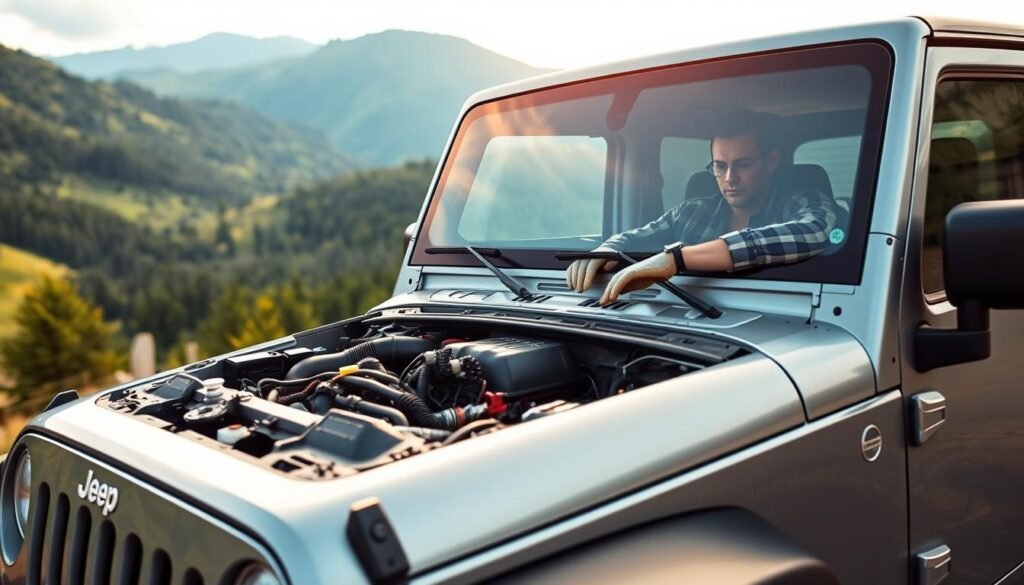
Best Gas Mileage For Jeep Wrangler Variants
The 2.0L Turbocharged Plug-In Hybrid (4xe) leads in gas mileage for Jeep Wranglers. It gets an amazing 49 MPGe. This version blends power with care for the environment.
The 2.0-liter turbo engine is great for everyday driving and adventures. It gives around 20 MPG in the city, 23 on the highway, and 21 combined.
It’s a top pick for anyone wanting both strength and fuel savings. The 3.6-liter V-6 models are suited for regular driving, offering a mix of power and practicality.
They’re not as fuel-efficient as hybrids but are loved for their dependability and performance. Knowing these options helps when choosing a Jeep Wrangler.
| Jeep Wrangler Variant | MPG (City/Highway/Combined) | MPGe (Electric) |
|---|---|---|
| 2.0L Turbocharged Plug-In Hybrid (4xe) | N/A | 49 |
| 2.0-liter Turbo Engine | 20 / 23 / 21 | N/A |
| 3.6-liter V-6 | 18 / 22 / 20 | N/A |
Conclusion
The jeep wrangler’s fuel economy changes a lot depending on the model, how it’s built, and how you drive.
Now, with new engine options, like hybrids, you get better fuel efficiency without losing power. This is important for people who love adventure but also watch their fuel use.
It’s key to understand how your choice of model and how you drive affects your jeep’s fuel use.
By using tips from this article, you’ll know how to choose better and use less fuel. This way, you won’t just be ready for off-road adventures but also save on fuel costs in daily life.
You’ll find a balance between exciting trips and everyday driving with your Jeep by applying what you’ve learned.
Remembering to maintain your vehicle and drive smartly helps make your fuel last longer on any journey.
This lets you enjoy every moment, knowing you’re getting the most out of your jeep wrangler’s fuel.
FAQs
Q: What is the fuel economy of the latest Jeep Wrangler models?
A: The fuel economy depends on the engine and model. The 2.0L Turbocharged Plug-In Hybrid (4xe) gets an impressive 49 MPGe. The 3.6-Liter Pentastar V-6 in 2-door models averages about 17/23/19 MPG.
Q: How can I improve the fuel efficiency of my Jeep Wrangler?
A: For better fuel efficiency, keep your Jeep maintained with regular oil changes and air filter checks. Watch your tire pressure, carry less weight, and drive smoothly.
Q: Does the transmission type affect gas mileage?
A: Yes, transmission type affects fuel economy. The eight-speed automatic gets better MPG than the six-speed manual, offering up to 18/24/20 MPG with the 3.6-liter V-6.
Q: How does vehicle weight influence the gas mileage of the Jeep Wrangler?
A: Lighter two-door Jeep Wranglers generally get better MPG than heavier four-door ones. Less weight means better overall efficiency.
Q: What are the best gas mileage options for daily driving?
A: For daily driving, the 2.0L Turbo Four-Cylinder and 2.0L Turbocharged Plug-In Hybrid (4xe) are top choices. They provide better MPG than older engines.
Q: Are there eco-friendly solutions available for the Jeep Wrangler?
A: Yes, the Jeep Wrangler 4xe shows hybrid technology progress. There are also eco-friendly conversion kits for those looking to use alternative fuels and lower their environmental impact.
Q: What driving conditions affect my Jeep Wrangler’s MPG?
A: Your MPG can vary widely between city and highway driving. In the city, expect 13 to 20 MPG. On the highway, you might see between 20 and 26 MPG.
Q: How do Jeep Wrangler trim levels impact fuel economy?
A: Jeep Wrangler’s fuel economy is affected by its trim level’s engine options and features. For instance, the Sport trim’s 3.6-liter V-6 averages 17/23/19 MPG. Meanwhile, the Sahara trim with a turbo engine might get 20/22/21 MPG.

